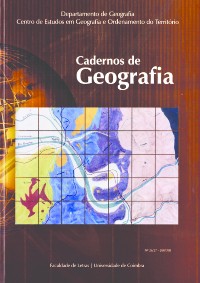Please use this identifier to cite or link to this item:
https://hdl.handle.net/10316.2/40242| Title: | Arquitetura de pedra solta, expressão marcante de um património cultural singular | Other Titles: | Architecture of terraces, expression of a unique cultural heritage Architecture de terrasses, l'expression d'un patrimoine culturel unique |
Authors: | Lourenço, Luciano Rebelo, Fernando Carvalho, Ana Nave, Adriano |
Keywords: | Terraces;Built heritage;Natural heritage;Rural landscape;Terrasses;Patrimoine bâti;Patrimoine naturel;Paysage rural;Socalcos;Património edificado;Património natural;Paisagem rural | Issue Date: | 2008 | Publisher: | Faculdade de Letras da Universidade de Coimbra | Abstract: | As directrizes subjacentes ao Terrisc, um projecto de recuperação de paisagens de socalcos e prevenção de riscos naturais, visaram inventariar as estruturas de socalcos existentes, definir o respectivo estado de conservação e, ainda, catalogar todo o vasto património arquitectónico que lhes está associado.
A construção de socalcos permitiu que, nas áreas de montanha do Centro de Portugal, se pudesse ter desenvolvido actividade agrícola em vertentes onde o valor dos declives os tornaria, à partida, locais inóspitos ao desenvolvimento desse tipo de actividade humana. No entanto, a luta pela sobrevivência levou à modelação da paisagem, tarefa que se desenvolveu ao longo de várias gerações e que configurou uma herança valiosa, actualmente votada ao abandono.
Embora de forma sintética, este trabalho visa revelar alguns aspectos desse vasto património edificado, essencialmente sustentado por um complexo sistema de muros de pedra solta que suportam numerosos campos em socalcos, hoje perfeitamente articulados e integrados de um modo muito peculiar no ambiente físico desta área. Les directives sous-jacentes au projet TERRISC, sur la restauration des paysages en terrasses et la prévention des risques naturels, visent à effectuer l'inventaire de ces structures, identifier leur état de conservation, et cataloguer le vaste patrimoine architectural qui leur est associé. La construction des terrasses, dans les zones de montagne au centre du Portugal, a favorisé la création d'une activité agricole là où les pentes très abruptes nuisent au développement de l'activité humaine. Ainsi, la lutte pour la survie a conduit à une transformation de la morphologie du paysage, ce savoir-faire s'est transmit de générations en générations et constitue un héritage précieux, désormais laissé à l'abandon. En résumé, ce travail vise à révéler certains aspects de ces édifices, essentiellement soutenus par un système complexe de roches, entièrement articulés et intégrés à la physique très particulière de ces espaces naturels. The guidelines of the Terrisc, a project of restoration of the terraced landscapes and prevention of natural hazards, aimed to make an inventory of the structures of terraces, to define their level of preservation and also to catalogue the vast architectural heritage associated to them. In the mountains of the Centre of Portugal, the construction of terraces allowed the development of agriculture activity, in areas where the slopes values would supposedly make them inhospitable places to the development of this type of human activity. However, this struggle for survival over several generations led to the changing of the landscape which, in fact, is a valuable legacy that as been left to abandonment nowadays. In conclusion, this paper aims to reveal some aspects of this vast heritage, sustained by a complex system of terraces, today perfectly articulated and integrated in this area physical aspect. |
URI: | https://hdl.handle.net/10316.2/40242 | ISSN: | 0871-1623 2183-4016 (digital) |
DOI: | 10.14195/0871-1623_27_3 | Rights: | open access |
| Appears in Collections: | Cadernos de Geografia |
Files in This Item:
| File | Description | Size | Format | |
|---|---|---|---|---|
| arquitectura_de_pedra_solta.pdf | 3.75 MB | Adobe PDF |  |
Items in DSpace are protected by copyright, with all rights reserved, unless otherwise indicated.
